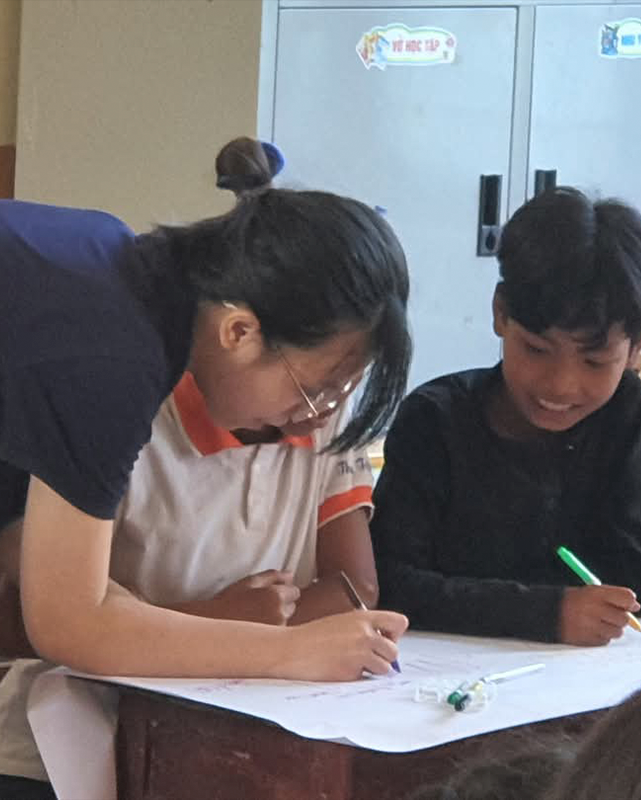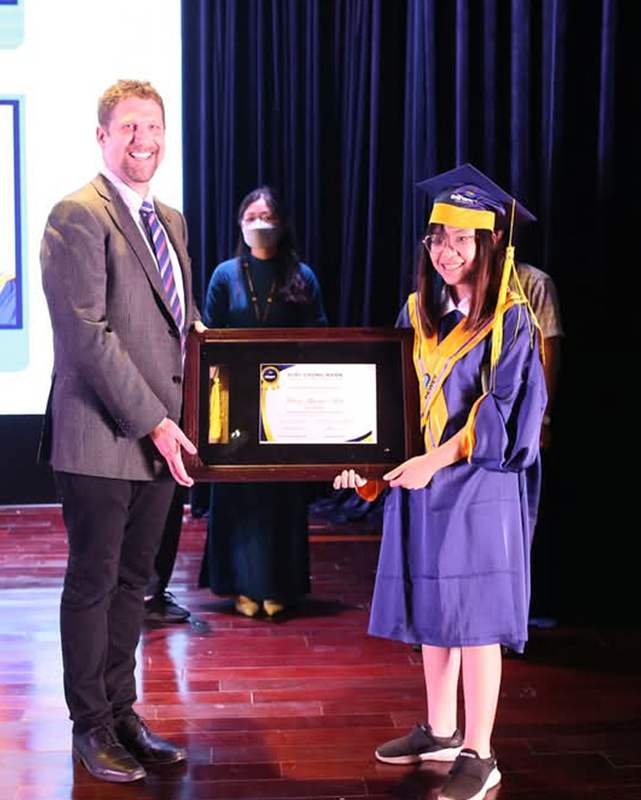At Mount Vernon, learning goes far beyond the classroom. It’s designed to help students develop the knowledge, empathy, and global perspective they need to thrive in an increasingly connected world. In Georgia Bickel’s Modern Journalism class in Upper School, a recent assignment brought that mission to life through powerful storytelling — and a meaningful cross-cultural collaboration. As part of the Journalistic Narrative Project, students were asked to explore a driving question:
What is it like to be a high school student in 2024?
While that question may seem straightforward, the goal was far more ambitious: to encourage students to consider how context, culture, and perspective shape the student experience — and to express that story in a voice that’s honest, thoughtful, and their own.
For Mount Vernon senior Cara Phan, who was born in Vietnam and attended preschool there, that meant teaming up with Anh Dang, one of four visiting seniors from The Dewey Schools in Vietnam, who shares a dynamic and purposeful partnership with Mount Vernon. Their collaboration offers more than a comparison of two education systems; it embodies the kind of global empathy, curiosity, and understanding that Mount Vernon strives to nurture in every learner.
Their story, Same Planet, Different Schools, was first published in December 2024 in the Mustang Memo — Mount Vernon’s digital newspaper created entirely by students for students. Written, formatted, and edited by the Mustang Memo Club, the publication is released three times a year and covers Arts, Athletics, Academics, Current Events, and Pop Culture.
Purposeful Learning, Global & Cultural Proficiency
The Journalistic Narrative Project is a clear example of how Mount Vernon’s mission comes to life — expanding not just individual worldviews but our community’s collective perspective through real-world learning.
Same Planet, Different Schools
We are seniors navigating two worlds, one classroom at a time.
By Cara Phan and Anh Dang
In Vietnam, we have something called sao đỏ — “red stars” who are basically student hall monitors on steroids. These kids, clipboard in hand, march into classrooms like mini-dictators, hunting for offenses like untucked shirts or a rogue candy wrapper on the floor. One mistake and your entire class loses points. It’s equal parts stress and spectacle, like living in an endless competition where the stakes are spotless floors and perfectly tucked uniforms.
“Stepping into a U.S. high school felt like entering uncharted territory — a place where there are no sao đỏ lurking in the hallways, but nonetheless plenty of other quirks to navigate.”
While Cara has been in the U.S. long enough to know how to pronounce “pep rally” without pausing, I’m still the newbie, fresh off the plane and constantly in awe of the differences. Together, we’ve noticed just how much culture and education intersect, from how students move between classes to what is served (or not served) at lunch.
In Vietnam, school is highly structured. You stay with one homeroom class all day, and the teachers come to you. There’s no shuffling between rooms, no comparing schedules, and no figuring out which way to turn when the halls split into confusing directions. But here? Students practically live out of their backpacks, darting between rooms like contestants in a scavenger hunt.
One of the first things that caught me off guard was how classes here aren’t strictly divided by age. Back in Vietnam, if you’re 16, you’re in 11th grade, no exceptions. But here, I’ve been in classes with freshmen, sophomores, and other seniors like me. It’s a little jarring to work on a group project and realize your partner wasn’t even in middle school when Frozen came out.
Then there’s the freedom to choose your classes. In Vietnam, your schedule is set in stone — math, science, literature, rinse, repeat. Specialized classes like theatre or pottery are practically unheard of. Here, you can take something like film studies or digital art, and no one bats an eye.
Cara personally loves how casual relationships with teachers are in the U.S. They’re like your friends here! You can crack a joke, and they’ll laugh instead of giving you the “you’re being disrespectful” look. In Vietnam, the teacher-student relationship is much more formal. You wouldn’t dream of addressing your teacher without using a title, and the idea of them laughing at one of your jokes? Unimaginable.
“Vietnamese schools taught us discipline and structure; the U.S. has given us freedom and opportunities to explore our interests.”
Lunch is another thing we’ve talked about at length. In Vietnam, school lunches are carefully planned, often featuring rice, vegetables, and some sort of protein. Here, lunch feels… optional. Pizza, fries, and mystery meat seem to dominate the menu. Cara joked that the salad bar at her previous public school looks like an afterthought, as if someone said, “Oh yeah, we should probably include vegetables.”
Transportation is also wildly different. In the U.S., school buses are everywhere. If you live far from school, there’s probably a big yellow bus with a huge stop sign ready to pick you up every morning. In Vietnam, public schools don’t typically provide transportation, so students either bike, walk, or get dropped off by parents. The lucky ones ride on the back of a motorbike, weaving through morning traffic like a scene from an action movie.
Of course, we can’t forget sports. Competitive sports are a massive part of American high school culture. Entire towns come together for football games, and student-athletes can even get scouted for college scholarships. In Vietnam, sports exist, but they’re not nearly as central to school life. Sports scholarships? Good joke. Academics is the utmost priority back home — often to an extreme.
This brings us to perhaps the most significant difference: the emphasis on grades. In Vietnam, grades are everything. They reflect not just your understanding of a subject but your worth as a student — and sometimes, sadly, as a person. The grading system is simple: scores from 1 to 10, with national exams determining your future. No personal essays, portfolios, or extracurricular achievements factored in.
In the U.S., grades still matter, but there’s more balance. Teachers consider effort, creativity, and participation. Parents seem more focused on well-being and growth. My dad, like many Vietnamese parents, initially struggled with the more relaxed approach. They’d see an 85 and ask, “Why not 100?” But over time, my family has learned to value growth beyond the numbers.
“School is never just about academics. It’s about the people, the culture, and the little moments that make each day unique.”
For both of us, being international students has been a journey of constant adaptation. We’ve learned to laugh at the absurdities — like still figuring out what a pep rally actually involves — and appreciate the strengths of each system. Vietnamese schools taught us discipline and structure; the U.S. has given us freedom and opportunities to explore our interests.
There’s one thing we’ve realized through this project: school is never just about academics. It’s about the people, the culture, and the little moments that make each day unique. Whether it’s a sao đỏ deducting points for an unironed shirt or a teacher joining you for a round of Fortnite, these experiences shape us in ways we never expected.
Now, if someone could just explain to me why football is played with hands and not feet, I think I’d finally have this American school thing figured out.
The story above offers all of us a reminder: learning is not just about mastering academics but about the small moments — a conversation, a new perspective, a step into the unfamiliar — that shape who we become.
As Mount Vernon’s global footprint grows, so does our opportunity — to listen deeply, think expansively, and lead with understanding. Through experiences like this, we are learning not just to tell stories but to build bridges between countries, cultures, and communities.
This is what it means to be truly globally competitive.





